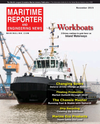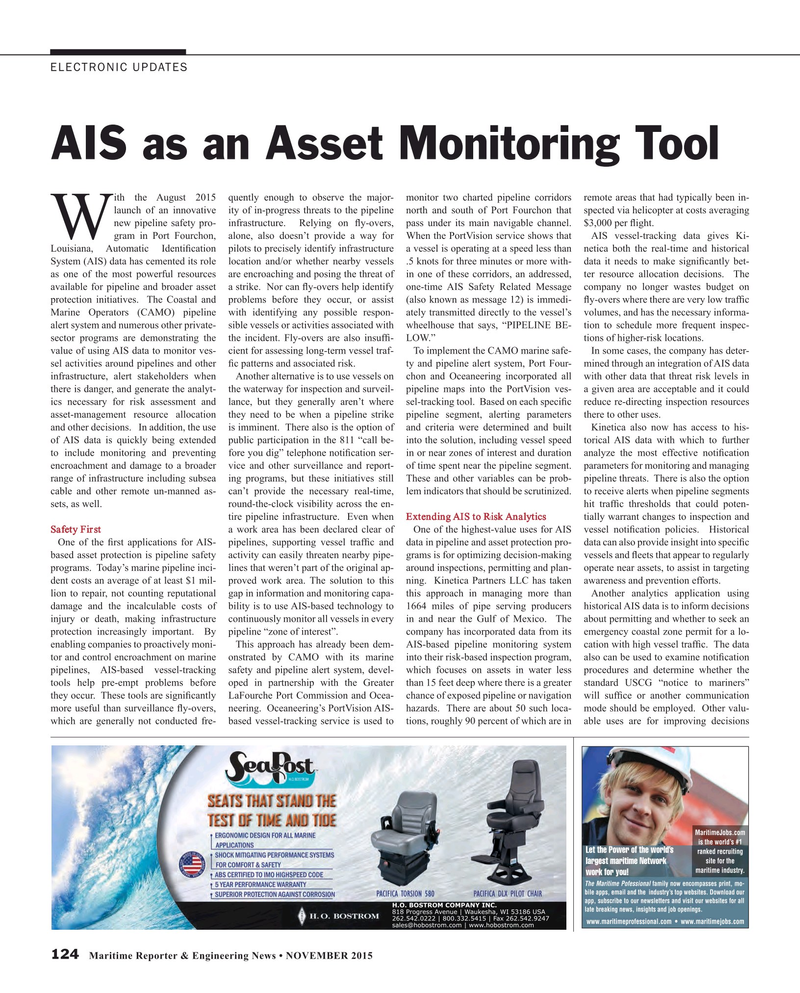
Page 124: of Maritime Reporter Magazine (November 2015)
Workboat Edition
Read this page in Pdf, Flash or Html5 edition of November 2015 Maritime Reporter Magazine
ELECTRONIC UPDATES
AIS as an Asset Monitoring Tool ith the August 2015 quently enough to observe the major- monitor two charted pipeline corridors remote areas that had typically been in- launch of an innovative ity of in-progress threats to the pipeline north and south of Port Fourchon that spected via helicopter at costs averaging new pipeline safety pro- infrastructure. Relying on ? y-overs, pass under its main navigable channel. $3,000 per ? ight.
Wgram in Port Fourchon, alone, also doesn’t provide a way for When the PortVision service shows that AIS vessel-tracking data gives Ki-
Louisiana, Automatic Identi? cation pilots to precisely identify infrastructure a vessel is operating at a speed less than netica both the real-time and historical
System (AIS) data has cemented its role location and/or whether nearby vessels .5 knots for three minutes or more with- data it needs to make signi? cantly bet- as one of the most powerful resources are encroaching and posing the threat of in one of these corridors, an addressed, ter resource allocation decisions. The available for pipeline and broader asset a strike. Nor can ? y-overs help identify one-time AIS Safety Related Message company no longer wastes budget on protection initiatives. The Coastal and problems before they occur, or assist (also known as message 12) is immedi- ? y-overs where there are very low traf? c
Marine Operators (CAMO) pipeline with identifying any possible respon- ately transmitted directly to the vessel’s volumes, and has the necessary informa- alert system and numerous other private- sible vessels or activities associated with wheelhouse that says, “PIPELINE BE- tion to schedule more frequent inspec- sector programs are demonstrating the the incident. Fly-overs are also insuf? - LOW.” tions of higher-risk locations. value of using AIS data to monitor ves- cient for assessing long-term vessel traf- To implement the CAMO marine safe- In some cases, the company has deter- sel activities around pipelines and other ? c patterns and associated risk. ty and pipeline alert system, Port Four- mined through an integration of AIS data infrastructure, alert stakeholders when Another alternative is to use vessels on chon and Oceaneering incorporated all with other data that threat risk levels in there is danger, and generate the analyt- the waterway for inspection and surveil- pipeline maps into the PortVision ves- a given area are acceptable and it could ics necessary for risk assessment and lance, but they generally aren’t where sel-tracking tool. Based on each speci? c reduce re-directing inspection resources asset-management resource allocation they need to be when a pipeline strike pipeline segment, alerting parameters there to other uses. and other decisions. In addition, the use is imminent. There also is the option of and criteria were determined and built Kinetica also now has access to his- of AIS data is quickly being extended public participation in the 811 “call be- into the solution, including vessel speed torical AIS data with which to further to include monitoring and preventing fore you dig” telephone noti? cation ser- in or near zones of interest and duration analyze the most effective noti? cation encroachment and damage to a broader vice and other surveillance and report- of time spent near the pipeline segment. parameters for monitoring and managing range of infrastructure including subsea ing programs, but these initiatives still These and other variables can be prob- pipeline threats. There is also the option cable and other remote un-manned as- can’t provide the necessary real-time, lem indicators that should be scrutinized. to receive alerts when pipeline segments sets, as well. round-the-clock visibility across the en- hit traf? c thresholds that could poten- tire pipeline infrastructure. Even when Extending AIS to Risk Analytics tially warrant changes to inspection and
Safety First a work area has been declared clear of One of the highest-value uses for AIS vessel noti? cation policies. Historical
One of the ? rst applications for AIS- pipelines, supporting vessel traf? c and data in pipeline and asset protection pro- data can also provide insight into speci? c based asset protection is pipeline safety activity can easily threaten nearby pipe- grams is for optimizing decision-making vessels and ? eets that appear to regularly programs. Today’s marine pipeline inci- lines that weren’t part of the original ap- around inspections, permitting and plan- operate near assets, to assist in targeting dent costs an average of at least $1 mil- proved work area. The solution to this ning. Kinetica Partners LLC has taken awareness and prevention efforts. lion to repair, not counting reputational gap in information and monitoring capa- this approach in managing more than Another analytics application using damage and the incalculable costs of bility is to use AIS-based technology to 1664 miles of pipe serving producers historical AIS data is to inform decisions injury or death, making infrastructure continuously monitor all vessels in every in and near the Gulf of Mexico. The about permitting and whether to seek an protection increasingly important. By pipeline “zone of interest”. company has incorporated data from its emergency coastal zone permit for a lo- enabling companies to proactively moni- This approach has already been dem- AIS-based pipeline monitoring system cation with high vessel traf? c. The data tor and control encroachment on marine onstrated by CAMO with its marine into their risk-based inspection program, also can be used to examine noti? cation pipelines, AIS-based vessel-tracking safety and pipeline alert system, devel- which focuses on assets in water less procedures and determine whether the tools help pre-empt problems before oped in partnership with the Greater than 15 feet deep where there is a greater standard USCG “notice to mariners” they occur. These tools are signi? cantly LaFourche Port Commission and Ocea- chance of exposed pipeline or navigation will suf? ce or another communication more useful than surveillance ? y-overs, neering. Oceaneering’s PortVision AIS- hazards. There are about 50 such loca- mode should be employed. Other valu- which are generally not conducted fre- based vessel-tracking service is used to tions, roughly 90 percent of which are in able uses are for improving decisions
MaritimeJobs.com is the world’s #1
Let the Power of the world’s ranked recruiting site for the largest maritime Network maritime industry.
work for you!
The Maritime Pofessional family now encompasses print, mo- bile apps, email and the industry’s top websites. Download our app, subscribe to our newsletters and visit our websites for all
H.O. BOSTROM COMPANY INC.
late breaking news, insights and job openings.
818 Progress Avenue | Waukesha, WI 53186 USA 262.542.0222 | 800.332.5415 | Fax 262.542.9247
WWWMARITIMEPROFESSIONALCOM

 123
123

 125
125
